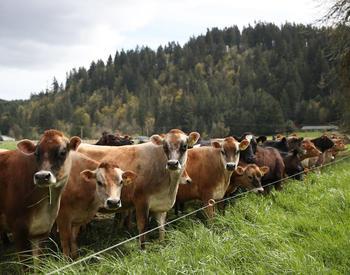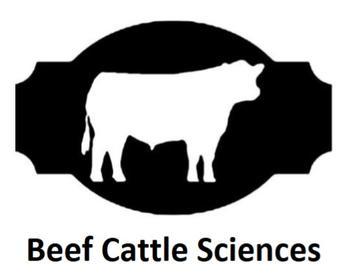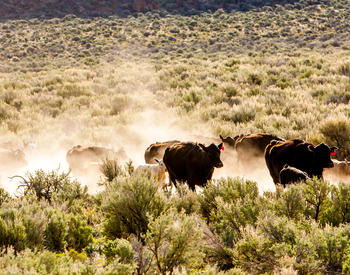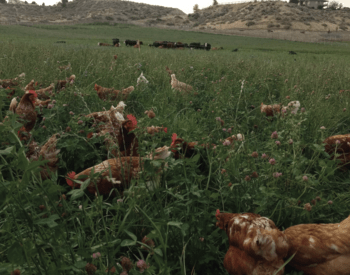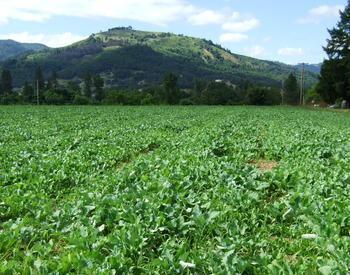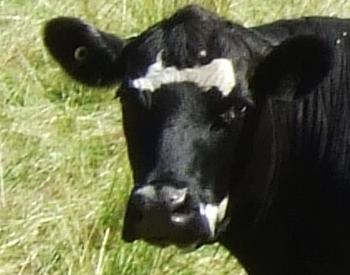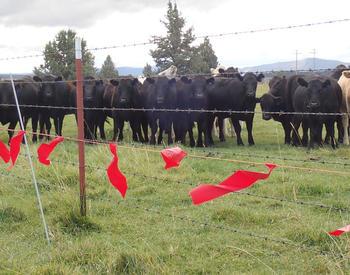Introduction
For over a century, the word temperament has been used to define the fear-related behavioral responses of cattle when exposed to human handling. As cattle temperament worsens, their response to human contact or any other handling procedures becomes more excitable.
In the beef cattle industry, producers select cattle for temperament primarily for safety reasons. However, recent studies demonstrate that cattle temperament may also have productive and economic implications to beef operations. This article will review some of the detrimental effects that excitable temperament has on productive traits of beef cattle.
Is excitable temperament a stress response?
First, we have to understand how temperament affects some of the body functions in cattle. Stress response is defined as the reaction of cattle to internal and external factors that affect their well-being, and animals that are unable to cope with these factors are classified as stressed. Examples are extreme temperatures, diseases, human handling and injuries.
Based on this concept, the agitated and/or aggressive responses expressed by cattle with excitable temperament when exposed to human handling can be attributed to their fear and consequent inability to cope with this situation; therefore classified as a stress response. In addition to altered behavior, temperamental cattle may also experience changes in their body physiology and the hormones produced during this fear-related stress reaction influence several factors, such as growth, health and reproduction.
One of the main hormones produced during stress responses is cortisol. Several studies reported that blood cortisol concentrations are greater in temperamental cattle compared to calm cattle (Table 1). Further, there is a positive relationship between the techniques utilized to assess temperament (see companion paper — Methods to evaluate temperament in beef cattle) with blood cortisol concentrations in cattle (Figure 1). This outcome validates that excitable temperament can be classified as a stress response, and is one of the reasons why cortisol is commonly considered paramount to the behavioral stress response.
| Animals | Calm temperament blood cortisol (ng/mL) | Excitable temperament blood cortisol (ng/mL) |
|---|---|---|
| Summer heifers | 28.4 | 39.4 |
| Fall heifers | 18.7 | 36.9 |
| Steers at weaning | 34.4 | 56.7 |
| Steers after weaning | 30.5 | 46.3 |
| Steers at feedlot entry2 | 83.2 | 144.2 |
| Cows | 5.7 | 66.1 |
Temperament and body weight gain
Several studies have demonstrated that temperament affects body weight gain in cattle. As cattle temperament becomes more excitable, their average daily gain (ADG) decreases (Table 2). This detrimental effect of excitable temperament on ADG can be attributed to at least three factors.
- Temperamental cattle spend more time inspecting their surroundings and reacting against “threats” instead of consuming forages and/or supplements, leading to decreased feed intake compared to calm cattle.
- The dietary nutrients that should be utilized for gain are reallocated to sustain the altered behavior of temperamental cattle.
- The altered body physiology of temperamental cattle directly impairs their body weight gain. As an example, elevated cortisol concentrations stimulate breakdown of body tissues, such as muscle and fat deposits, in order to release energy and protein to further support the behavioral stress response.
| Temperament | ADG, lbs/d |
|---|---|
| chute score feedlot heifers and steers - 14 | 2.6 |
| chute score feedlot heifers and steers - 2 | 2.5 |
| chute score feedlot heifers and steers - 3 | 2.3 |
| chute score feedlot heifers and steers - 4 | 2.2 |
| chute score feedlot heifers and steers - 5 | 2.1 |
| temperament score replacement heifers4 - below 2.5 | 1.3 |
| temperament score replacement heifers - above 2.5 | 1.0 |
| temperament feedlot steers5 - calm | 3.3 |
| temperament feedlots steers - nervous | 2.2 |
Temperament and carcass quality
Besides impairing growth rates, excitable temperament also has detrimental effects on carcass quality. Excitable temperament is typically associated negatively with final carcass weight and carcass yield grade. Further, research studies reported that excitable temperament increases the incidence of dark cutters, decrease meat tenderness, and also increase percentage of bruised carcasses (Table 3). Therefore, temperament affects carcass not only by reducing ADG and consequently carcass yield, but also directly alters meat quality.
.
| Chute Score | % Dark cutters | % of carcasses classified as tender | Average bruised tissue trimmed from carcasses, lbs |
|---|---|---|---|
| 1 | 6.7 | 88.9 | 3.6 |
| 2 | 4.2 | 90.8 | 4.6 |
| 3 | 7.9 | 76.3 | 5.4 |
| 4 | 25 | 60.0 | 5.6 |
| 5 | - | - | 5.3 |
| 6 | - | - | 10.3 |
Temperament and reproduction
Nutritional status largely determines reproductive performance in cattle; therefore, excitable temperament may indirectly impair reproduction in beef heifers and cows by decreasing nutritional balance, as previously described. Also, the hormones produced during a stress response, particularly cortisol, directly disrupt the physiological mechanisms that regulate reproduction in beef females, such as ovulation, conception, and establishment of pregnancy.
As an example, cows with calm temperament have reduced cortisol and greater blood concentrations of luteinizing hormone, the hormone required for puberty establishment and ovulation, compared to temperamental cows. Accordingly, it was recently demonstrated that beef heifers with calm temperament reached puberty sooner than temperamental cohorts (Table 4). Further, beef cows with excitable temperament had decreased chances of becoming pregnant during the breeding season compared their calmer cohorts (Figure 2).
Similar relationships were detected when blood cortisol concentrations were evaluated against puberty or pregnancy instead of temperament in those heifers and cows (Table 4 and Figure 2). Therefore, excitable temperament has detrimental effects on reproduction of beef females, which are likely mediated by elevated cortisol concentrations.
| Item | Pubertal | Non-Pubertal |
|---|---|---|
| Temperamental Score | 2.3 | 2.7 |
| Cortisol, ng/mL | 39.7 | 50.0 |
Temperament and health
Excitable temperament also alters the immune response of cattle. Elevated cortisol concentrations for prolonged periods lead to cases of immunosuppression, which means that cattle are more susceptible to diseases. Further, breakdown of body tissues triggered by cortisol and other hormones during a behavioral stress response may lead to inflammatory reactions within the animal.
Research has shown that cattle with excitable temperament have increased blood concentrations of inflammatory markers such as ceruloplasmin (Figure 3), an endogenous protein that is synthesized in significant amounts (blood concentrations above 35 mg/dL) during inflammatory responses. It is important to remember that immune status not only determines the health condition in cattle, but also affects growth and reproduction.
Improving temperament of beef cattle
One alternative to improve temperament and consequently benefit cattle production is to adapt them to human handling. Early studies reported that cattle acclimated to human handling had calmer temperament and reduced blood cortisol concentrations compared to non-acclimated cattle.
Recently, replacement heifers exposed to an acclimation process to human handling for 4 weeks after weaning had improved temperament, reduced cortisol, reached puberty and became pregnant earlier compared to non-acclimated cohorts (Table 5). However, no beneficial effects on temperament and performance were detected when mature cows were exposed to acclimation to human handling.
Therefore, adapting beef cattle to human interaction early in their productive lives may be an alternative to improve their temperament and consequently enhance their development and productivity.
Including temperament in culling/selection criteria might be the most appropriate alternative to improve the overall temperament and consequent performance of the adult cow herd. Furthermore, temperament is a heritable trait; therefore selecting the cow herd for good temperament will also improve temperament of future progeny.
| Item | Acclimated | Control |
|---|---|---|
| Chute score, 1-5 scale | 1.4 | 1.9 |
| Cortisol, ng/mL | 37.8 | 50.5 |
| Pubertal heifers by 12 months of age | 65 | 39 |
| Pregnant heifers 30 days into breeding season, % | 50 | 32 |
Conclusion
In summary, excitable temperament is a fear-related behavioral response that has detrimental effects on growth, carcass quality, reproduction and health of beef cattle. Beef producers can evaluate cattle temperament by visual assessments that can be conducted during common handling procedures, such as assessing chute score when cattle have to be handled for vaccination or weaning (see companion paper — Methods to evaluate temperament in beef cattle).
Depending on the outcomes, producers can adopt management strategies to improve the overall temperament of the cow herd. Examples are early age acclimation to human handling and consideration of temperament in selection/culling decisions, which will bring benefits to cattle performance and consequent productivity of beef operations containing temperamental cattle.
References
Cooke et al., 2009a. J. Anim. Sci. 87: 3403-3412.
Cooke et al., 2009b. J. Anim. Sci. 87: 4125 - 4132.
Echternkamp. 1984. Theriogenology 22:305-311
Fell et al., 1999. Aust. J. Exp. Agric. 39:795-802
Fordyce et al., 1988. Aust. J. Exp. Agric. 28:689-693.
Hammond et al., J. Anim. Sci. 74:295-303.
Voisinet et al., 1997a. J. Anim, Sci, 75:892-896.
Voisinet et al., 1997b. Meat Sci. 4:367-377.
This document is part of the Oregon State University Beef Cattle Library [BEEF021]. Prior to acceptance, this document was anonymously reviewed by two experts in the area.
- 1Adapted from Hammond et al. (1996), Fell et al. (1999), and Echternkamp (1984).
- 2Following truck transportation for 200 miles.
- 3Adapted from Voisinet et al. (1997a), Fell et al. (1999), and Cooke et al. (2009a).
- 4 a b As score increases, chute behavior and temperament becomes more excitable.
- 5Calm, average exit velocity = 0.84 yards/second; average chute score = 1.4; nervous, average exit velocity = 1.98 yards/second; average chute score = 3.4.
- 6Adapted from Fordyce et al. (1988) and Voisinet et al. (1997b). Dark cutters and carcasses classified as tender have chute score assessed on 1 – 4 scale. As score increases, chute behavior becomes more excitable. Average bruised tissue trimmed from carcasses have chute score assessed on 1 – 6 scale. As score increases, chute behavior becomes more excitable.
- 7 a b Adapted from Cooke et al. (2009a).
- 8Acclimated heifers were exposed to a handling process 3 times weekly for 4 weeks after weaning. Control heifers remained undisturbed on pasture.

